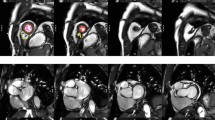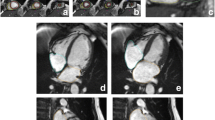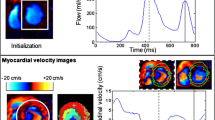Abstract
Objectives
Reference ranges of left ventricular (LV) parameters from cardiac magnetic resonance (CMR) were established to investigate the impact of ageing and hypertension as important determinants of cardiac structure and function.
Methods
One thousand five hundred twenty-five contrast-enhanced CMRs were conducted in the Study of Health in Pomerania. LV end-diastolic volume (LVEDV), end-systolic volume (LVESV), stroke volume (LVSV), ejection fraction (LVEF), and myocardial mass (LVMM) were determined using long- and short-axis steady-state free-precession sequences. The reference population was defined as participants without late enhancement, hypertension, and prior cardiovascular diseases. Reference ranges were established by quantile regression (5th and 95th percentile) and compared with an additional sample of treated and untreated hypertensives.
Results
LV volumes in the reference population (n = 634, 300 males, 334 females, 52.1 ± 13.3 years) aged between 20-69 years were lower with higher age (p = 0.001), whereas LVEFs were higher (p ≤ 0.020). LVMM was lower only in males (p = 0.002). Compared with the reference population, hypertension was associated with lower LVEDV in males (n = 258, p ≤ 0.032). Antihypertensive therapy was associated with higher LVEF in males (n = 258, +2.5%, p = 0.002) and females (n = 180, +2.1%, p = 0.001).
Conclusions
Population-based LV reference ranges were derived from contrast-enhanced CMR. Hypertension-related changes were identified by comparing these values with those of hypertensives, and they might be used to monitor cardiac function in these patients.
Key Points
• Left ventricular function changed slightly but significantly between 20-69 years.
• Reference values of BSA-indexed myocardial mass decreased with age in males.
• Hypertension was associated with lower LV end-diastolic volume only in males.
• CMR may allow assessing remodelling related to hypertension or antihypertensive treatment.




Similar content being viewed by others
Change history
19 April 2018
The original version of this article, published on 14 March 2018, unfortunately contained a mistake.
Abbreviations
- ATC:
-
Anatomical therapeutic chemical
- BSA :
-
Body surface area
- CI:
-
Confidence interval
- CMR:
-
Cardiac magnetic resonance
- ECG:
-
Electrocardiogram
- LGE:
-
Late gadolinium enhancement
- LV:
-
Left ventricular
- LVEDV:
-
Left ventricular end-diastolic volume
- LVEF:
-
Left ventricular ejection fraction
- LVESV:
-
Left ventricular end-systolic volume
- LVMM:
-
Left ventricular myocardial mass
- LVSV:
-
Left ventricular stroke volume
- MR:
-
Magnetic resonance
- SD:
-
Standard deviation
- SHIP:
-
Study of Health in Pomerania
- SSFP:
-
Steady-state free precession
- TE:
-
Echo time
- TR:
-
Repetition time
References
Miller AL, Dib C, Li L et al (2012) Left ventricular ejection fraction assessment among patients with acute myocardial infarction and its association with hospital quality of care and evidence-based therapy use. Circ Cardiovasc Qual Outcomes 5:662–671
Mewton N, Opdahl A, Choi EY et al (2013) Left ventricular global function index by magnetic resonance imaging--a novel marker for assessment of cardiac performance for the prediction of cardiovascular events: the multi-ethnic study of atherosclerosis. Hypertension 61:770–778
Grebe O, Kestler HA, Merkle N et al (2004) Assessment of left ventricular function with steady-state-free-precession magnetic resonance imaging. Reference values and a comparison to left ventriculography. Z Kardiol 93:686–695
Fiechter M, Fuchs TA, Gebhard C et al (2013) Age-related normal structural and functional ventricular values in cardiac function assessed by magnetic resonance. BMC Med Imaging 13:6
Alfakih K, Plein S, Thiele H, Jones T, Ridgway JP, Sivananthan MU (2003) Normal human left and right ventricular dimensions for MRI as assessed by turbo gradient echo and steady-state free precession imaging sequences. J Magn Reson Imaging 17:323–329
Cain PA, Ahl R, Hedstrom E et al (2009) Age and gender specific normal values of left ventricular mass, volume and function for gradient echo magnetic resonance imaging: a cross sectional study. BMC Med Imaging 9:2
Kawel-Boehm N, Maceira A, Valsangiacomo-Buechel ER et al (2015) Normal values for cardiovascular magnetic resonance in adults and children. J Cardiovasc Magn Reson 17:29
Natori S, Lai S, Finn JP et al (2006) Cardiovascular function in multi-ethnic study of atherosclerosis: normal values by age, sex, and ethnicity. AJR Am J Roentgenol 186:S357–S365
Chuang ML, Gona P, Hautvast GL et al (2014) CMR reference values for left ventricular volumes, mass, and ejection fraction using computer-aided analysis: the Framingham Heart Study. J Magn Reson Imaging 39:895–900
Petersen SE, Aung N, Sanghvi MM et al (2017) Reference ranges for cardiac structure and function using cardiovascular magnetic resonance (CMR) in Caucasians from the UK Biobank population cohort. J Cardiovasc Magn Reson 19:18
Volzke H, Alte D, Schmidt CO et al (2011) Cohort profile: the study of health in Pomerania. Int J Epidemiol 40:294–307
Hegenscheid K, Kuhn JP, Volzke H, Biffar R, Hosten N, Puls R (2009) Whole-body magnetic resonance imaging of healthy volunteers: pilot study results from the population-based SHIP study. Rofo 181:748–759
(2014) Observational studies: getting clear about transparency. PLoS Med 11:e1001711
Levey AS, Bosch JP, Lewis JB, Greene T, Rogers N, Roth D (1999) A more accurate method to estimate glomerular filtration rate from serum creatinine: a new prediction equation. Modification of Diet in Renal Disease Study Group. Ann Intern Med 130:461–470
Kieback AG, Lorbeer R, Wallaschofski H et al (2012) Claudication, in contrast to angina pectoris, independently predicts mortality risk in the general population. Vasa 41:105–113
Juergens KU, Grude M, Maintz D et al (2004) Multi-detector row CT of left ventricular function with dedicated analysis software versus MR imaging: initial experience. Radiology 230:403–410
Schulz-Menger J, Bluemke DA, Bremerich J et al (2013) Standardized image interpretation and post processing in cardiovascular magnetic resonance: Society for Cardiovascular Magnetic Resonance (SCMR) board of trustees task force on standardized post processing. J Cardiovasc Magn Reson 15:35
Du Bois D, Du Bois EF (1989) A formula to estimate the approximate surface area if height and weight be known. 1916. Nutrition 5:303–311 discussion 312-303
Giavarina D (2015) Understanding Bland Altman analysis. Biochem Med (Zagreb) 25:141–151
Wei Y, Pere A, Koenker R, He X (2006) Quantile regression methods for reference growth charts. Stat Med 25:1369–1382
Hudsmith LE, Petersen SE, Francis JM, Robson MD, Neubauer S (2005) Normal human left and right ventricular and left atrial dimensions using steady state free precession magnetic resonance imaging. J Cardiovasc Magn Reson 7:775–782
Yeon SB, Salton CJ, Gona P et al (2015) Impact of age, sex, and indexation method on MR left ventricular reference values in the Framingham Heart Study offspring cohort. J Magn Reson Imaging 41:1038–1045
Pfluger HB, Maeder MT, LaGerche A, Taylor AJ (2010) One- and two-dimensional estimation of right and left ventricular size and function-comparison with cardiac magnetic resonance imaging volumetric analysis. Heart Lung Circ 19:541–548
Berkovic P, Hemmink M, Parizel PM, Vrints CJ, Paelinck BP (2010) MR image analysis: Longitudinal cardiac motion influences left ventricular measurements. Eur J Radiol 73:260–265
de Simone G, Devereux RB, Izzo R et al (2013) Lack of reduction of left ventricular mass in treated hypertension: the strong heart study. J Am Heart Assoc 2:e000144
Eng J, McClelland RL, Gomes AS et al (2016) Adverse Left Ventricular Remodeling and Age Assessed with Cardiac MR Imaging: The Multi-Ethnic Study of Atherosclerosis. Radiology 278:714–722
Ambale-Venkatesh B, Lima JA (2015) Cardiac MRI: a central prognostic tool in myocardial fibrosis. Nat Rev Cardiol 12:18–29
Funding
This study has received funding from the following institutions: Federal Ministry of Education and Research, the Ministry of Cultural Affairs as well as the Social Ministry of the Federal State of Mecklenburg-West Pomerania. Magnetic resonance imaging examinations were supported by Siemens Healthineers, Siemens Healthcare GmbH (Erlangen, Germany).
Author information
Authors and Affiliations
Corresponding author
Ethics declarations
Guarantor
The scientific guarantor of this publication is Robin Bülow, MD (buelowr@uni-greifswald.de).
Conflict of interest
The authors of this manuscript declare no relationships with any companies, whose products or services may be related to the subject matter of the article.
Statistics and biometry
One of the authors, Till Ittermann, has significant statistical expertise.
Informed consent
The local ethics committee approved the study, and written informed consent was obtained from all participating volunteers before contrast-enhanced cardiac magnetic resonance imaging.
Ethical approval
Institutional Review Board approval was obtained.
Study subjects or cohorts overlap
The cardiac magnetic resonance imaging sub-study was part of the population-based Study of Health in Pomerania (SHIP), a project conducted in northeast Germany. To date nothing has been previously published about the cardiac magnetic resonance imaging data in SHIP although the study population is a sample of the whole-body MR imaging project, which has produced numerous scientific publications.
Methodology
• retrospective
• cross-sectional study/observational
• performed at one institution
Additional information
The original version of this article was revised: The sequence of the author names was incorrect, Robin Bülow was mentioned twice.
Electronic supplementary material
ESM 1
(DOCX 96926 kb)
Rights and permissions
About this article
Cite this article
Bülow, R., Ittermann, T., Dörr, M. et al. Reference ranges of left ventricular structure and function assessed by contrast-enhanced cardiac MR and changes related to ageing and hypertension in a population-based study. Eur Radiol 28, 3996–4005 (2018). https://doi.org/10.1007/s00330-018-5345-y
Received:
Revised:
Accepted:
Published:
Issue Date:
DOI: https://doi.org/10.1007/s00330-018-5345-y




